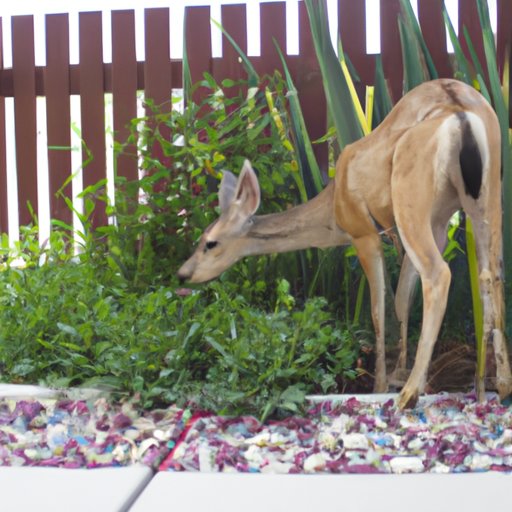Introduction
Deer are a common sight in many gardens and yards, and while they may add charm and beauty to the landscape, they can also be quite destructive. Deer have a tendency to eat plants, which can be quite frustrating for gardeners who have spent time and money on their plants. Fortunately, there are a few steps that can be taken to prevent deer from eating plants and protect gardens from these four-legged plant-eaters.
The purpose of this article is to provide an overview of the various methods for preventing deer from eating plants. We will explore different strategies such as planting deer-resistant plants, installing physical barriers, using repellents, setting up motion-activated sprinklers, utilizing natural predators, employing hunting or trapping, and trying out taste deterrents.
Plant Deer-Resistant Plants
One of the best ways to prevent deer from eating plants is to plant deer-resistant plants. These are plants that deer tend to avoid due to their unpleasant smell, taste, texture, or prickly foliage. Examples of deer-resistant plants include lavender, rosemary, thyme, daffodils, and lantana.
When planting deer-resistant plants, it’s important to consider where deer are most likely to visit. For instance, deer tend to avoid areas with bright lights and loud noises, so it’s best to plant deer-resistant plants in these areas. Additionally, deer are more likely to avoid areas with tall grasses and dense shrubs, so it’s a good idea to plant these types of plants near the garden.
Install Physical Barriers
Another way to keep deer away from plants is to install physical barriers around the garden. Common types of barriers include fences, netting, and screens. Fences are the most popular option, as they are relatively inexpensive and easy to install. However, they must be at least 8 feet high in order to be effective. Netting and screens are also effective, but they can be more costly and difficult to install.
Physical barriers are effective, but they do have some drawbacks. For example, they can be unsightly and can block views of the landscape. In addition, they must be regularly maintained to ensure that they are still functioning properly.
Use Deer Repellents
Repellents are another option for keeping deer away from plants. Repellents work by emitting a scent or taste that deer find unpleasant, which encourages them to stay away from the treated area. There are a variety of deer repellents available, including liquid sprays, granules, and pellets.
When applying repellents, it’s important to follow the directions on the package carefully. Generally, repellents should be applied every two weeks or after heavy rainfalls. It’s also important to reapply the repellent after pruning or mowing the lawn.
Install Motion-Activated Sprinklers
Motion-activated sprinklers are a great way to keep deer away from plants. These devices detect movement and emit a sudden burst of water, which startles the deer and encourages them to leave the area. Motion-activated sprinklers are relatively inexpensive and easy to set up. They can be used in combination with other methods, such as physical barriers or repellents, for maximum effectiveness.
When setting up a motion-activated sprinkler system, it’s important to choose a spot that is close to the plants being protected. The sprinkler should be set to emit a burst of water when it detects motion, and the spray should be directed away from the plants. Additionally, it’s important to check the batteries regularly to ensure that the system is working properly.
Utilize Natural Predators
Using natural predators is another effective method for keeping deer away from plants. Natural predators of deer include coyotes, foxes, bears, and bobcats. If natural predators are present in the area, they can help deter deer from entering the garden.
There are a few pros and cons to using natural predators. On the one hand, they can help to keep deer away from plants without the need for human intervention. On the other hand, they can also pose a risk to pets and livestock, and they may not always be effective.
Employ Hunting or Trapping
In some cases, it may be necessary to hunt or trap deer in order to keep them away from plants. Before attempting to hunt or trap deer, it’s important to check local regulations and restrictions. Depending on the area, there may be specific rules regarding hunting and trapping.
When hunting or trapping deer, it’s important to use the right equipment and techniques. For example, it’s best to use a rifle rather than a bow and arrow, as it is more accurate and has a greater range. Additionally, bait should be placed in areas where deer are likely to visit, such as wooded areas or near water sources.
Try Using a Taste Deterrent
Taste deterrents are a type of repellent that makes plants taste unpleasant to deer. These products contain ingredients that are safe for humans and animals, but that deer find unappealing. Examples of taste deterrents include garlic oil, hot pepper, and ammonium soaps.
When using a taste deterrent, it’s important to follow the instructions on the package carefully. Generally, these products should be applied every two weeks or after heavy rainfalls. Additionally, it’s important to reapply the deterrent after pruning or mowing the lawn.
Conclusion
Deer can be a nuisance in gardens and yards, but there are a few steps that can be taken to prevent them from eating plants. By planting deer-resistant plants, installing physical barriers, using repellents, setting up motion-activated sprinklers, utilizing natural predators, employing hunting or trapping, and trying out taste deterrents, gardeners can protect their plants from hungry deer.
(Note: Is this article not meeting your expectations? Do you have knowledge or insights to share? Unlock new opportunities and expand your reach by joining our authors team. Click Registration to join us and share your expertise with our readers.)
